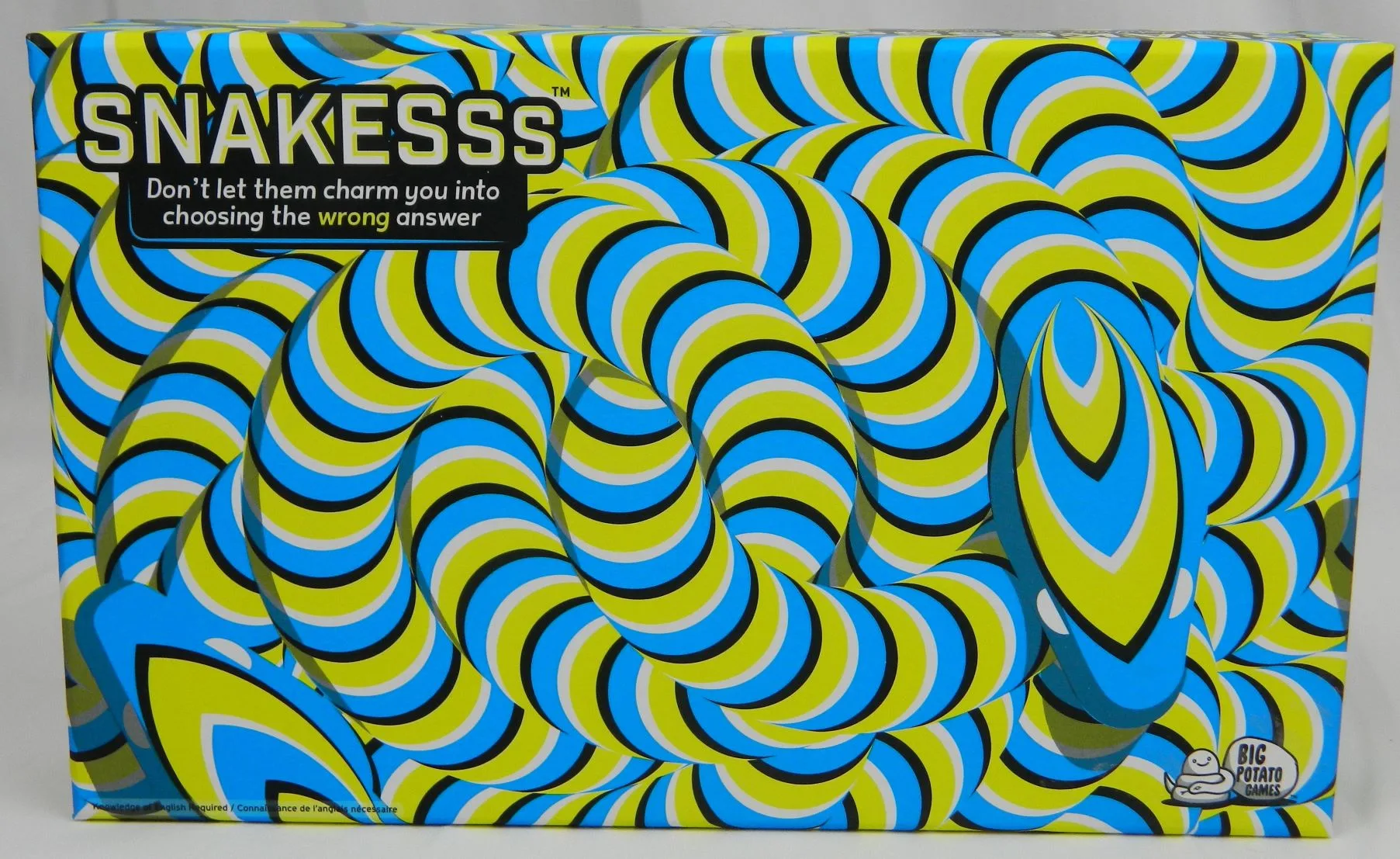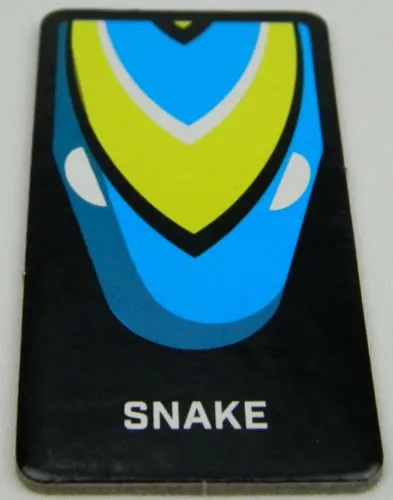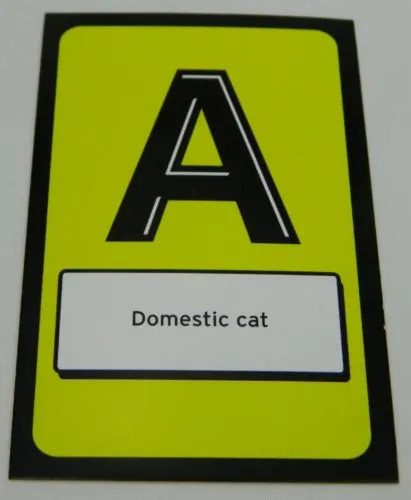After you have played as many different games that I have played you start to develop favorite game designers. There are a handful of designers that I have played enough of their games to know that I will likely enjoy any game that they put out. One of those designers is Phil Walker-Harding. In the past we have played Cloud City, Gizmos, Silver & Gold, Sushi Go, and Sushi Go Party. Having played five different games from the same designer and giving all of them a high rating, it is pretty easy to tell that I am a big fan. That is why I was intrigued when I was given the opportunity by Big Potato Games to try out the latest Phil Walker-Harding game, Snakesss. One thing that I have always liked about his games is that he likes to take well established genres and add unique twists to them to make them feel fresh again. This is what intrigued me about Snakesss as it takes your typical trivia game and mixes it with a social deduction game. Snakesss is a fun and interesting take on your typical trivia game that will work great as a party game for larger groups.
How to Play Snakesss
Setup
- Write each player’s name on the scoresheet.
- Each player is given a set of Answer Chips (A, B, C, Snake).
- Choose the most sensible player to be the moderator. The moderator will play the game like everyone else, but will be responsible for reading cards and flipping over cards.
- A number of Character Tokens are chosen based on the number of players.
| Number of Players | 4 | 5 | 6 | 7 | 8 |
|---|---|---|---|---|---|
| Ordinary Humans | 1 | 2 | 2 | 3 | 3 |
| Snakes | 2 | 2 | 3 | 3 | 4 |
| Mongoose of Truth | 1 | 1 | 1 | 1 | 1 |
Playing the Game
The game is played over six rounds. Each round consists of a couple phases.
Choosing Your Role
The Character Tokens are shuffled face-down. One token is dealt face-down to each player. Each player will look at their token without letting the other players see it.
Whoever is dealt the Mongoose of Truth token will flip it over and take the wood mongoose figure. This will let the other players know that you are not a Snake and that the other Ordinary Humans can trust that you are trying to get everyone to guess the right answer.
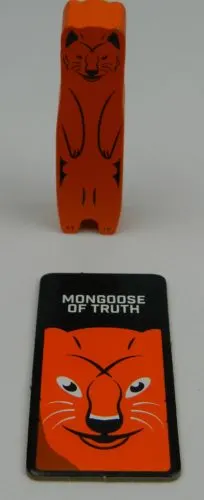
This player was given the Mongoose of Truth Character Token. They will take the wooden figure to show the other players that they are the Mongoose of Truth for this round.
The Question
The moderator will take the top trivia card from the stack. They will read it out loud making sure no one can see the back of the card. The card will then be placed question side up in the middle of the table.
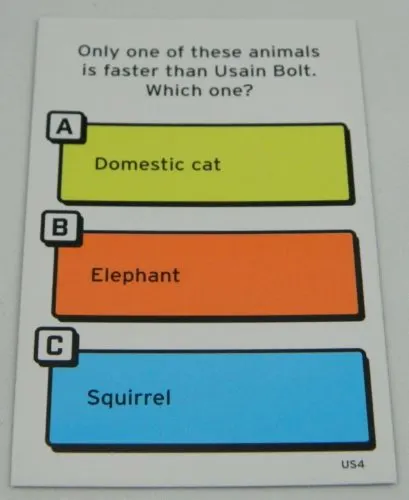
For this round the players were given the question “Only one of these animals is faster than Usain Bolt. Which one? A) Domestic cat B) Elephant C) Squirrel.
The moderator will then guide the rest of the players through the following steps:
- Everyone closes their eyes.
- The moderator turns the question card over without looking at it. On the back of the card is the answer to the question.
- The moderator will then tell the Snake players to open their eyes. The Snake players will look at the back of the card in order to see what the answer to the question is.
- After five seconds the moderator will tell the Snakes to close their eyes.
- The question card is then flipped back to the question side. Everyone can then open their eyes.
The Discussion
A two minute timer is now set. The players will have two minutes to discuss the answers and try to convince the other players what answer is correct. The Ordinary Humans and Mongoose of Truth are trying to figure out the correct answer. The Snake players knowing the correct answer will try to convince the other players to choose one of the incorrect answers.
Choosing An Answer
After the players have finished discussing the answers, all of the players will have to choose one of their Answer Chips and place it face-down on the table. Ordinary Humans and the Mongoose of Truth will pick the letter that corresponds to the answer that they think is correct. The Snakes will place their Snake Chip face down.
When everyone is done all of the chips are flipped over. The moderator will then flip over the question card to reveal the answer. Points will then be scored based on how players answered.
Each Ordinary Human and Mongoose of Truth that answered correctly will earn a point for the group that answered correctly. For example if three Ordinary Humans/Mongoose of Truth answered correctly, all of them that answered correctly will receive three points.
For each Ordinary Human and Mongoose of Truth that picked the wrong answer, all of the Snake players will earn one point.
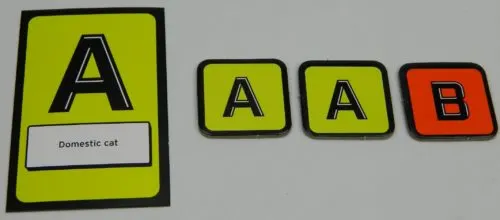
As the answer to this round’s question was A, players will score points as follows. The two Ordinary Humans/Mongoose of Truth that guessed A will receive two points. The Snakes will earn one point due to the one player guessing the wrong answer.
Each players’ score will be recorded on the scoresheet. If less than six rounds have been played, another round is played. The Character Tokens are shuffled and a new one is given to each player.
End of Game
The game ends after six rounds. The player that scores the most points wins the game. If there is a tie, the tied players will break the tie with a game of “rock, paper, snakesss.”
My Thoughts on Snakesss
A genre that has become pretty popular in the board game industry in recent years is the social deduction genre. Basically among the group of players there will be one or more traitors that are secretly working against the other players. Despite the number of games released for this genre over the years, I have mostly stayed away from it for one main reason. This genre generally relies on large groups to reach their full potential. This usually isn’t a option for our group as the minimum number of players are usually higher than our group size. This genre is also the type that will appeal to some people more than others. It isn’t the type of game that really appeals to a number of members of our group.
I bring this up because Snakesss’ gameplay can basically be summed up as what you would get if you took a traditional trivia game and combined it with a game like Werewolf or another social deduction game. The trivia element of the game is pretty simple. The Ordinary Humans and the Mongoose of Truth are trying to figure out the correct answer to a trivia question in order to score points. Unlike most trivia games though, players can actively discuss the answers in order to help one another. The catch is not everyone will be truthful when discussing the answers. There will be a number of Snakes that will purposefully try to mislead the other players into picking an incorrect answer as that is how they will score points. Therefore each player can never truly know whether the other players are genuinely trying to help them get the right answer or if they are deceiving them.
This combination of a trivia game and a social deduction game is what initially intrigued me about Snakesss. As I mentioned at the beginning of this review, one of the things that I like the most about Phil Walker-Harding’s games is that he generally tries to take a well established genre of game and twist it in a new way. For the most part I think he succeeds with Snakesss as well.
I have played a lot of different board games (around 1,000 at this point) and yet I can’t recall ever playing a game quite like Snakesss before. The trivia itself is pretty typical of what you would expect from a lot of games from the genre. Instead of focusing on boring facts though, a lot of the questions tend to be based around random little facts/tidbits. I thought this was a good decision for the game as I generally like this type of trivia, plus it works well with the rest of the other mechanics as a lot of the questions feel vaguely familiar but not enough where you actually know the answer.
This is where the social deduction element of the game comes into play. While I wouldn’t say that I am the biggest fan of social deduction games, I actually thought it worked well with the trivia elements. I found it kind of interesting that the number of Snakes is basically equal to the number of players that are actually trying to come up with the right answer. This allows the Snake players to work together in order to trick the other players especially since they know who the other Snakes are. Therefore you never truly know who is telling the truth outside of the Mongoose of Truth. As players are unlikely to actually know the right answer, a convincing Snake could easily deceive players into picking an incorrect answer. Between trying to figure out the right answer yourself, you need to also try to figure out who is trying to deceive you. This creates an interesting gameplay experience that I can’t recall from any other trivia game that I have ever played.
While Snakesss is a trivia game at its core, in many ways it is just as much of a social deduction game. Because of this I will say that your feelings towards social deduction games is going to have a pretty big impact on how much you enjoy Snakesss. To enjoy the game you need to be willing to actively lie and try to deceive the other players, while also rooting out when other players are lying to you. To get the most enjoyment out of the game you need to actively participate in the discussion phase. If no one is discussing the answers, the game kind of suffers. This is illustrated by the fact that the members of my group that actively participated in the discussions enjoyed the game considerably more than those that never really got involved. If you generally don’t care for social deduction games, I don’t see Snakesss being for you. Those that enjoy the genre are likely to really enjoy this game as well.
Other than coming up with unique twists on typical board game genres, one other thing that I generally enjoy about games made by Phil Walker-Harding is that he does a really good job balancing accessibility and strategy. It is a little debatable how much strategy there is to Snakesss. Basically your success in the game will come down to how many of the answers you actually know/can figure out, and how good you are at deceiving the other players. The game does give you some leniency in this area though as players don’t know if you are deceiving them or telling the truth. Even if they suspect you of being a Snake, you could try convincing them of picking the right answer so they think you are lying and thus pick a different answer. Those that are good at deceiving or reading other players will do well in the game.
On the accessibility front, the game does a great job. Most of the game’s mechanics are really simple. The only real learning curve might come from teaching players unfamiliar with social deduction games about the idea of some people being traitors while others are being honest. Otherwise there is nothing difficult about the game’s mechanics. The game could probably be taught to most new players within just a couple minutes. With how simple the game is, it also plays pretty quickly. Unless players spend more than the allotted time discussing a question, I would guess that most games should be finished within 20-30 minutes. This should make Snakesss a great party game.
Being a party game does illustrate arguably the biggest issue I had with Snakesss though. One of the main reasons that I haven’t played many social deduction games is that it generally requires quite a few players to reach their full potential. Most games in this genre don’t even support less than five or six players. This is why I was intrigued by the game only requiring four players. Having played the game with only four players I would say that it plays fine with the minimum number of players. The social deduction elements still work. It is kind of odd that the Ordinary Human as well as the Snakes actually know the roles of all of the other players due to process of elimination though. This forces the Snakes to change up their strategy if they want to successfully deceive the other two players.
For this reason, I would probably say that Snakesss is the type of game where more players is likely better. You can play the game with only four players and still enjoy it. If possible though I would recommend playing with as many players as possible. I think this is due to a couple of reasons. First it is pretty easy to figure out who the Snakes are as everyone but the Mongoose of Truth knows who everyone else is in the four player game. Thus you have to play more of a game of whether the Snakes are deceiving you or if they want you to think that they are. With more players it will genuinely be harder to tell and thus the Snakes have more opportunity to deceive the other players. With more players the discussions should go better as well. With only four players if one or two players don’t really add to the conversation it feels like something is missing from the game. More players will allow more people to jump in and keep the discussion going for longer. This will also make it easier for the Snakes to work together to craft a story to mess with the other players. For these reasons and others I think the game will really thrive at six to eight players.
Other than the game being better with more players, the other main issue with the game is that as a Snake it is not always easy to bluff the other players. This in particular is true when there is a question that one of the Ordinary Humans or Mongoose of Truth actually knows the answer to. If one of them can make a really convincing argument for an answer, it is really hard to convince players otherwise. For some of the questions it is also just hard to come up with sound reasoning why one answer is a better option than others. These questions don’t come up often, but there were questions where no one could really come up with much to discuss. In these cases it is hard to deceive as players end up mostly guessing, so they will just go with their gut feeling. This is not a big problem as it doesn’t come up that often, but these rounds are obviously not as enjoyable as those where there is an actual good discussion of the answers.
Before wrapping up lets quickly talk about the components. I liked them for the most part. The game mostly comes with the trivia cards, answer chips, and character tokens; but I thought they were pretty nice. While the Mongoose of Truth figurine wasn’t particularly necessary, I am always a fan of wood components. The game’s artwork is pretty simple and straight to the point, but it works well for the game. Probably my biggest issue with the components is just the fact that the game only has 120 question cards. With each game only using six cards, there is enough for 20 games. If you take some time between plays you likely will forget the answers to most of the cards when you circle back to the first cards. Like with all games though, I would always appreciate more cards. I am wondering if the game does well if additional cards will be released for the game or if a second edition will include different cards.
Should You Buy Snakesss?
In a lot of ways Snakesss is a lot like what I expected it to be. While not quite as good as some of Phil Walker-Harding’s other games that I have played, Snakesss is still a good game. On the surface the game is similar to your typical trivia game where you score points for guessing the right answer. Not all of the players are being truthful though as they are trying to deceive the other players into guessing an incorrect answer. Snakesss feels a lot like what you would get if you combined a traditional trivia game with a social deduction game. Your enjoyment of the game is going to depend on your opinion of social deduction games as to fully enjoy it you need to embrace deceiving others and trying to figure out who the saboteurs are. These two mechanics actually work quite well together even though there will be some rounds where it is hard to actively deceive the other players. While it is fine as a four player game, I would probably recommend playing with as many players as possible as that will make the deception elements more prevalent in the game. Snakesss is easy to pick up and quick to play which should make it a great party game.
Ultimately my recommendation for Snakesss comes down to your thoughts on combining a trivia and social deduction game. If you don’t really care for either genre, I don’t know if Snakesss will be for you. Those that are intrigued by the idea though should enjoy Snakesss and consider picking it up.
Buy Snakesss online: Target.com
We would like to thank Big Potato Games for the review copy of Snakesss used for this review. Other than receiving the review copy we at Geeky Hobbies received no other compensation. Receiving the review copy had no impact on the content of this review or the final score.

